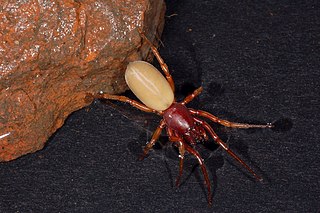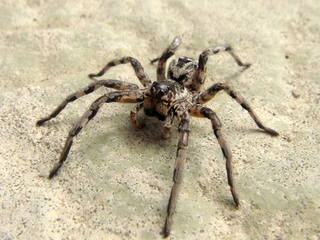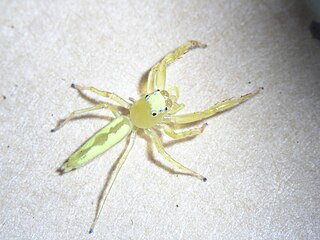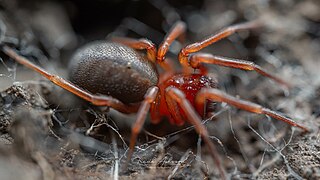
Dysderidae, also known as woodlouse hunters, sowbug-eating spiders, and cell spiders, is a family of araneomorph spiders first described by Carl Ludwig Koch in 1837. They are found primarily in Eurasia, extending into North Africa with very few species occurring in South America. Dysdera crocata is introduced into many regions of the world.

Lycosa tarantula is the species originally known as the tarantula, a name that nowadays in English commonly refers to spiders in another family entirely, the Theraphosidae. It now may be better called the tarantula wolf spider, being in the wolf spider family, the Lycosidae. L. tarantula is a large species found in southern Europe, especially in the Apulia region of Italy and near the city of Taranto, from which it gets its name.
Henriksenia nepenthicola, synonym Misumenops nepenthicola, is a species of crab spider. It is native to Singapore. It lives inside the pitchers of a number of lowland Nepenthes pitcher plants. As such, it is classified as a nepenthephile. They are slow-moving spiders which do not actively hunt. Males and females both reach a length of 6 mm.

Stagetillus is a monotypic genus of Southeast Asian jumping spiders containing the single species, Stagetillus opaciceps. It was first described by Eugène Louis Simon in 1885, and is found in Indonesia, Philippines and Malaysia.

Periegops is a genus of spiders with six eyes instead of the usual eight. It is the only genus in its family (Periegopidae) and has three described species. It was long considered to be a member of Sicariidae or Segestriidae until Raymond Forster elevated it to the family level in 1995.
Lophostica mauriciana is a species of spider in the family Salticidae. It is found only in the islands of Mauritius and Réunion in the western Indian Ocean.

Pseudeuophrys lanigera is a species of jumping spider that is distributed throughout Europe.

Harpactea is a genus in the family Dysderidae. Harpactea is a replacement name published by W. S. Bristowe in 1939 for the unavailable name "Harpactes" published by R. Templeton in 1835, which had already been used for a genus of birds. They are non-web building predators that forage on the ground and on tree trunks at night, mainly in xerothermic forests. During the day, they hide in silk retreats they build under rocks or bark.

Agalenatea redii is a species of 'orbweavers' belonging to the family Araneidae subfamily Araneinae.

Holocnemus is a genus of cellar spiders that was first described by Eugène Louis Simon in 1873.

Drassodes cupreus is a species of spider in the genus Drassodes, family Gnaphosidae. A ground-living nocturnal hunter, it spends the day in a silken retreat.

Theridiosoma gemmosum is a species of spider in the family Theridiosomatidae, known as ray spiders. It is widely distributed in the Holarctic region. A small spider with a shiny globular abdomen, it constructs a conical orb web.

Pseudicius squamatus is a species of jumping spider in the genus Pseudicius that lives in South Africa. The spider was first defined in 2013 by Charles Haddad and Wanda Wesołowska. The spider is small, with a cephalothorax that is between 1.4 and 1.7 mm long and an abdomen that measures between 1.2 and 1.8 mm long. It has a dark brown carapace that has three narrow white stripes of hairs running down it and a pattern of a streak that terminates in a series of chevrons on the abdomen. It is the copulatory organs that most enable the spider to be distinguished. The female has a characteristic triangular depression in its epigyne. The male has a series of black scales on the side of the cymbium near to the tip of its embolus. The species is named in recognition of those scales.
Dysdera castillonensis is a species of spider in the genus Dysdera, family Dysderidae. The species, endemic to Spain, was first described by Miguel Ferrández in 1996.

Tliltocatl schroederi is a species of spiders in the family Theraphosidae (tarantulas), found in Mexico. It is found in the central valley in Oaxaca State, Mexico.

Stenaelurillus guttiger is a species of jumping spider in the genus Stenaelurillus that is native to southern Africa. It was first described in 1901 by Eugène Simon based on examples found in South Africa, and subsequently also identified in Botswana, Mozambique and Zimbabwe. Initially allocated to the genus Aelurillus, the species was moved to its current genus in 1974. The spider is medium-sized, with a carapace that is between 2.0 and 2.75 mm long and an abdomen that is between 1.8 and 2.9 mm long. It is dark brown or brown, and has a pattern of white hairs on both the abdomen and carapace and a pattern of two stripes on the carapace. The abdomen has a white pattern of straight and V-shaped stripes and spots which varies between specimens. The colouring of the clypeus and legs can also range from yellow to dark brown depending on the particular example. It is distinguished from other species in the genus by the design of its sexual organs. The male has an embolus that is short and crab like. The female has a flat plate epigyne with widely separated copulatory openings and insemination ducts and a deep narrow pocket. Stenaelurillusguttiger feeds on termites, particularly Macrotermes and Odontotermes.

Stenaelurillus pseudoguttatus is a species of jumping spider in the genus Stenaelurillus that lives in Namibia. The species was first described in 2018 by Dmitri Logunov and Galina Azarkina. The holotype had originally been described by Wanda Wesołowska and Meg S. Cumming in 2002 and allocated to the genus Mashonarus guttatus but was recognised as a new species 16 years later. Stenaelurillus pseudoguttatus takes its name from the fact that it had previously been named in the type series of this other species, now named Stenaelurillus guttatus. Only the male has been identified. The spider is medium-sized, with a carapace 2.28 mm (0.090 in) long and an abdomen 2.05 mm (0.081 in) long. The carapace is yellow-brown and has two white stripes, while the abdomen is a dark brown with six white spots. It can be distinguished from both Stenaelurillus brandbergensis and Stenaelurillus guttatus by its long sword-like embolus.
Rhondes berlandi is an endemic species of jumping spider in the genus Rhondes that lives in New Caledonia. First described in 2016 by Barbara Patoleta, the species has been found on both Grande Terre and Isle of Pines, living in rainforests. Only the female has yet to be described. It is small and slender, with a wide brown hairy cephalothorax and thinner abdomen that is patterned with light and dark patches. The species can be distinguished from the related Rhondes flexibilis by its wide epigynal pocket.
Rhondes sarasini is an endemic species of jumping spider in the genus Rhondes that lives in New Caledonia. First described in 2016 by Barbara Patoleta, only the female has yet to be identified. The holotype was discovered by Jean Roux and Karl Friedrich Sarasin in 1911, and the species name commemorates the latter. It is a small and slender spider, with a wide light brown cephalothorax that is typically 3.2 mm (0.13 in) long and a thinner abdomen, typically 5 mm (0.20 in) long, that has a pattern of light and dark patches. It differs from other members of the genus in its design of the epigyne, which has a wide pocket and short copulatory openings.














